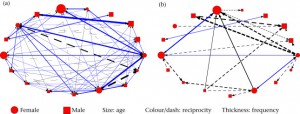I Scratch Your Back, You Scratch Mine: Lemurs Groom-at-a-Distance through Vocalizations

Ring-tailed Lemurs (Lemur catta)
http://cincinnatizoo.org/wp-content/uploads/2011/02/ring-tailed-lemur.jpg
We have all heard it before: communication is the key to a successful relationship. Talking things out with friends and family is healthy for everyone involved. But what about grooming? Getting a nice massage every now and then from your partner would surely lend a hand to a stronger bond, right? Well, if you are a lemur, absolutely. Like us, lemurs are a highly social species, with much of their communication revolving around both vocalizations and physical contact with each other through grooming.
But as ideal as the physical act of grooming may be for maintaining social bonds, it is a rather time-consuming task. What happens if you and your partner(s) are too far away to scratch each other’s backs? How do you keep your relationship strong? That’s where vocal networks come in. According to Dunbar’s “Gossip” hypothesis, as primate groups get larger, group members start to form social bonds with more conspecifics, until a threshold is reached, where grooming each conspecific becomes too time consuming. Since vocal exchanges are not nearly as time-consuming as grooming and they can travel over large distances quickly, they provide a bonding mechanism for the members. Ring-tailed lemurs (Lemur catta), in particular, have learned how to relate their vocal calls, or contact calls (Figure 1), to grooming with their conspecifics, an idea termed “grooming-at-a-distance” by the researchers Kulahci, Rubenstein, and Ghazanfar (2015).

Figure 1.
Spectrogram of a ringtailed lemur contact call. Lemur contact calls are long-distance calls that elicit vocal responses from group members
In their study, Kulahci, Rubenstein, and Ghazanfar investigated whether vocal exchanges among ring-tailed lemurs (Lemur catta) reflected the social bonds among their group members. They hypothesized that 1) if the lemur contact calls function to maintain social bonds, then socially bonded individuals should be more likely to respond to each other’s calls, and 2) if the contact calls additionally function as grooming-at-a-distance, then they should be sufficient to produce selective vocal responses even when the lemur sounding the contact call is not in close proximity to the respondents.
To test their hypotheses, the researchers collected data on grooming between group members and performed vocalization playback experiments with four lemur groups: two groups were semifree-ranged in a forest enclosure, and the other two were free-ranged on an island. For each group, vocalization of each group member was presented once to the entire group by an iPod connected to a mobile speaker. The focal lemur, whose vocalization was presented to the group, was isolated in an indoor enclosure away from the other group members, and an HD camcorder was used to record playback of contact calls and simultaneously capture the actions of the other lemurs on video. The data on vocalization and grooming was then nicely converted into weighted networks (Figure 3) to show the frequency of grooming and vocal interactions between the individual group members.

Figure 3.
Representative (a) grooming and (b) vocalization networks from one group of ringtailed lemurs (N = 17). Thicker lines indicate frequent grooming interactions (a) or vocal responses (b). Arrows point towards the recipient. In the vocalization network, arrows point towards the lemur receiving a vocal response after having vocalized first. Blue solid lines indicate reciprocal interactions or responses (i.e. individual A responded to individual B, and individual B responded to individual A at another time); black dashed lines indicate nonreciprocal interactions or responses
Overall, the researchers found that some lemurs were very social and frequently engaged in grooming interactions while also frequently producing vocal responses to the calls of others, which was in accordance with their first hypothesis. This suggested that lemurs who groomed more members also vocalized in response to more members. Additionally, they found that as the groups got larger the lemurs mainly responded to the calls of those members they groomed most frequently, which supports their second hypothesis. And because the vocal selectivity persisted during the playback experiments, it shows that vocal responses are independent of other cues, like olfaction and vision, suggesting that the vocalizations may function as grooming-at-a-distance.
Studies like these hold great significance with regards to the evolution of primate vocal communication. Understanding how other social species communicate can give us great insight as to where we humans have come from and where we are going. So next time you crave a long-distance massage, maybe ask your partner to do it with their voice? I guess that’s what Skype is for.
Reference:
Kulahci, I. G., Rubenstein, D. I. & Ghazanfar, A. A. (2015). Lemurs groom-at-a-distance through vocal networks. Animal Behaviour, 110: 179-186.
